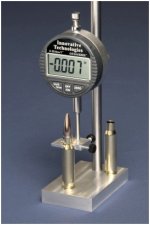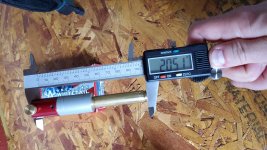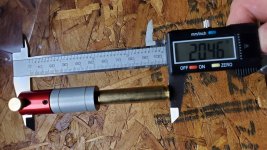Hacksaw a stretched case longitudally. That will let you see what you are probing with the paper clip test. It will look almost like an o-ring groove inside the case.
My estimate of .006 isn't anything magic, I spent many years building plastic injection molds. I had to learn to think in terms of building steel components that would create a cavity /core that would mold precision parts.
A rifle chamber has some similarity. Its relatively predictable if you learn to envision what you are dealing with.
Your rifle seems to be manufactured to correct spec. No reason to think in terms of "fixing" it.
Its great you now have a tool to check your cases and die settings! Sure beats speculating in the dark!
I don't know what happened with your first firing of the factory loads. If you have any unfired ones left try measuring them. Look for short rounds.
I don't know what is best for you. I can tell you what came to be best for me.
I did not like being at the mercy of what loaded rounds are in stock on the shelf.
I sight in precisely. Buying a substitute load meant another range session to verify.
Then there was the hodge podge mix of brass. I prefer knowing my inventory .
The solution (for me) is biting the bullet and buying virgin brass. For myself, Winchester brass has proven a reliable value. There IS other good brass.
For a hunting rifle that does not run a high round count, I'd order 200 pieces.
I'd work out of 100 pieces and have 100 reserve. I'd consider 50 rounds to be a typical range session or a "using" box. The other 50 rounds would be someplace between "being processed" and "loaded and ready"
Primers and bullets come packed 100 at a time. Easy to keep notes and know the brass has been "loaded three times" You can get those nice 50 round plastic boxes.
I suggest getting a set of mechanic's feeler gauges. The little folding kit. Not expensive. Given reloading dies might take your brass back to minimum spec,(.006 stretch) try a .004 feeler gauge between your shellholder and sizing die when you set up. See if that gets you .002 head clearance. Thats good for a bolt gun.
You get the idea? Handloading has benefits.
One more concept. Tolerancing. This actually came from wartime aircraft production. Picture you are Rosie the Riveter making B-17 parts.
Imagine I am a mechanic at some forward air base patching shot up B-17s.
You send me parts held on by 1/4 in bolts. Tolerance on the holes is .257 to .281. Great! You are enamored with PRECISION so you drill the holes .261.
Quality! But there are 12 holes in the part and I have to bolt that part on the aircraft I have at a jungle air strip. The holes don' t quite line up so I have to spend an hour filing to fit,cut and try.
|
HMMM. What if you drilled the holes .279? The part still meets spec,you can control that diameter easily within the .281, and now I have no problem screwing the screws through the .279 holes. The part bolts up!.
Another bonus is ,with all the holes in a B-17,we save some weight!
The gun manufacturers have to make guns to fit the longest SAAMI ammo so the guns accept all spec rounds.
The ammo manufacturers have to make ammo to fit the tightest chambered SAAMI rifles produced.So the make them on the short side.
They might control production of guns and ammo to .001 in production today,
But the headspace will lean toward max, and the ammo will lean toward min, so every round fits every gun easy. Once.
Little concern is given to your brass life.
Point: Your rifle is not an accident on the edge of being a reject. Building to max headspace is probably production standard, as is min spec ammo.
The handloader (who can measure) can deal with it.
You will get plenty of advice to adjust a die 1/4 or 1/8 turn. Thats what I did for years.
The dies have 14 threads per inch. divide one by 14, You will get something like roughly .075 in per turn. HMMM So 1/4 turn is near .020,+ or -.
1/10 turn is .0075 . We are trying to solve a .006 problem. Would we like something more precise and repeatable? Do you think so?
Once again,the feeler gauge between the shellholder and the die



